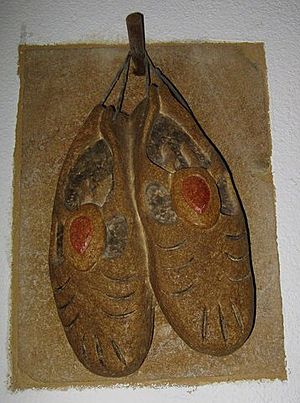Thomas Coryat facts for kids

Thomas Coryat (also spelled Coryate) was an English traveler and writer who lived from about 1577 to 1617. He is best known for the two books he wrote about his journeys, which he often made on foot, across Europe and parts of Asia. People often say he was the one who brought the table fork to England. Because of this, one of his nicknames was "Furcifer," which means "fork-bearer" in Latin. He also described how Italians used something to protect themselves from the sun, which led to the word "umbrella" being used in English.
Contents
Life and amazing journeys
Thomas Coryat was born in Crewkerne, a town in Somerset, England. He spent most of his life in the nearby village of Odcombe. His father was George Coryate. Thomas went to Winchester College from 1591 and then studied at Gloucester Hall, Oxford from 1596 to 1599.
From 1603 to 1607, he worked for Henry Frederick, Prince of Wales, who was the oldest son of King James I of England. Thomas was a bit like a "court jester" or entertainer, working alongside famous writers like Ben Jonson and John Donne.
Traveling through Europe
In 1608, from May to October, Thomas went on a big trip across Europe. He walked for almost half of his journey! He traveled through France and Italy all the way to Venice. Then he came back through Switzerland, Germany, and the Netherlands.
He wrote all about his adventures in a book called Coryat's Crudities hastily gobbled up in Five Months Travels in France, Italy, &c, which was published in 1611. This book gives a really clear picture of what life was like in Europe at that time.
His book is especially important for people who study music history. It shares amazing details about the Venetian School, which was a very famous and modern music group in Europe back then. He described a big celebration at a church in Venice called San Rocco, where they played music with many choirs and instruments.
In 1611, he published another travel book called Coryats Crambe, or his Coleworte twice Sodden. Thomas also wrote letters that mentioned the famous Mermaid Tavern in London. He talked about Ben Jonson, John Donne, and other friends who were part of a drinking club there.
Journey to Asia
Thomas was always eager to travel. In 1612, he started another journey, this time heading towards Asia. He visited Greece and the eastern Mediterranean, including Constantinople (now Istanbul) by 1614. He then walked through Turkey, Persia, and eventually reached Mughal India by 1615. There, he visited the court of Emperor Jahangir in Ajmer, Rajasthan.
From places like Agra, he sent letters home describing what he saw and did. One of his books, Greetings from the Court of the Great Mogul, was published in London in 1616. Another book of his letters came out after he died in 1618.
In September 1617, he visited the imperial court at Mandu, Madhya Pradesh. In November 1617, he left for Surat. Sadly, he died there in December of that year from a serious stomach illness, which was made worse by drinking too much wine. He had planned to write a full account of his journey, but he never got to finish it. However, some of his notes survived and were brought back to England. These notes were later published in a book by Samuel Purchas in 1625.
Thomas Coryat's writings were very popular when he was alive. His descriptions of old writings and carvings, many of which are now lost, were very valuable. His stories about Italian customs, like using the table fork, also influenced England. Many people think he was the first British person to do a "Grand Tour" of Europe. This became a common way for young, wealthy English men to complete their education in the 1700s.
What he left behind
We are not entirely sure where Thomas Coryat was buried. There wasn't a regular English cemetery in Surat back then. One traveler said he was buried north of the town, but another said he was buried at Swally (Suvali).
There is a monument near Suvali that looks like a dome on pillars, in a Muslim style. Some people think this might be his tomb, but there are no writings or clues to prove it. Other travelers who visited India later mentioned seeing his tomb along with others outside a gate in Surat. However, the exact location of this gate is now unknown. During the British period, an official tried to find the tomb but thought it had been lost in floods from the Tapi River.
Modern travel writers have been inspired by Thomas Coryat.
- William Dalrymple, a British travel writer, called Coryat "one of my travel-writing heroes."
- Tim Moore, another British travel writer, followed Coryat's European journey for his book Continental Drifter (2000).
- In 2008, Daniel Allen wrote The Sky Above, The Kingdom Below about his nine-month bike trip following Coryat's journey to the East.
- Tony Wheeler, who founded Lonely Planet, spoke about Thomas Coryat and even visited what he believed was Coryat's tomb in 2010.
See also
 In Spanish: Thomas Coryat para niños
In Spanish: Thomas Coryat para niños



